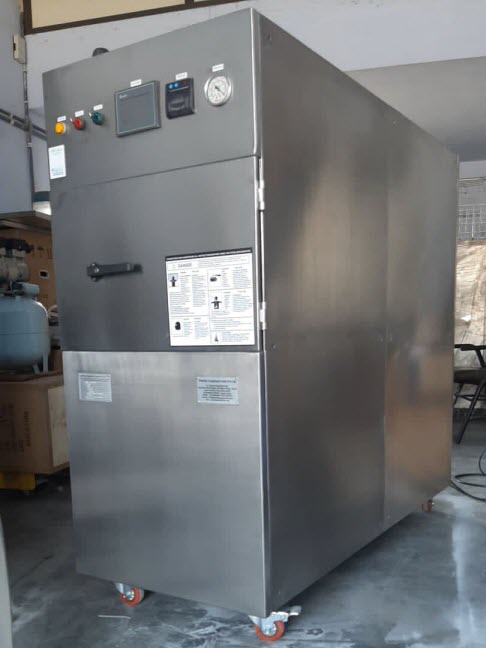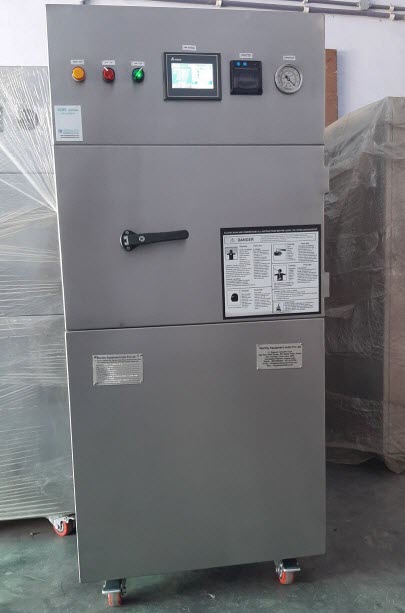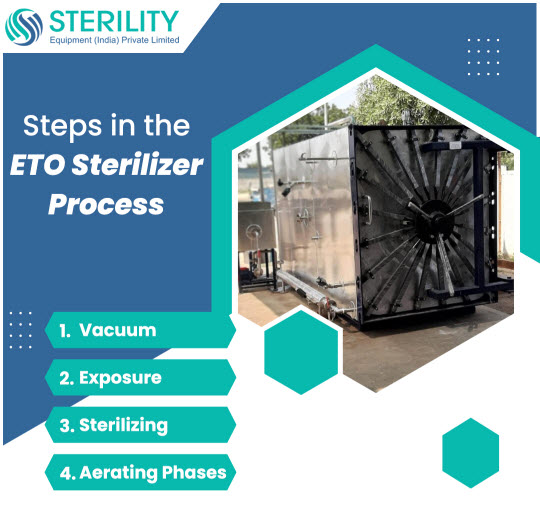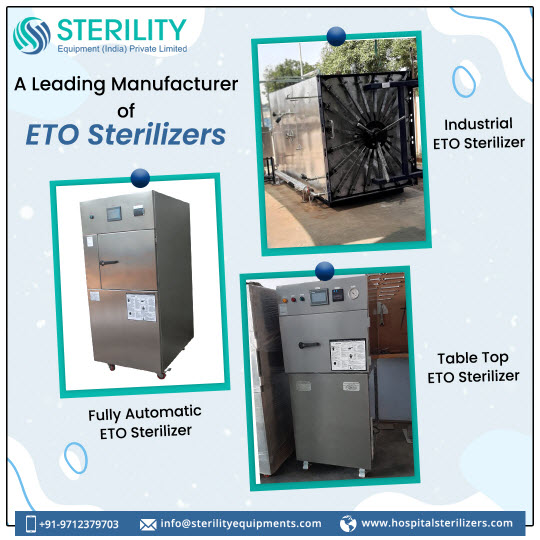Understanding ETO Sterilization Validation
In this section, we will explore the process of ETO (ethylene oxide) sterilization validation and its crucial role in ensuring safety and efficacy. By examining the key components of risk assessment, we can gain a deeper understanding of how this validation process works and its importance in maintaining high standards.
The Significance of Risk Assessment in ETO Sterilization Validation
Risk assessment plays a critical role in ETO sterilization validation, as it helps identify and mitigate potential risks associated with the process. By evaluating various factors and considering the possible hazards, we can implement effective measures to ensure the safety and efficacy of the sterilization procedure.
Key Components of Risk Assessment in ETO Sterilization
To conduct a thorough risk assessment in ETO sterilization validation, several key components need to be considered. We will explore these components, which include exposure levels, material compatibility, and potential hazards. By analyzing these factors, we can develop strategies to minimize risks and enhance the overall validation process.
Evaluating Exposure Levels in ETO Sterilization
Evaluating exposure levels is a crucial aspect of ETO sterilization validation. This involves assessing the concentration of ethylene oxide, exposure time, and temperature during the sterilization process. By carefully evaluating these parameters, we can determine the potential risks associated with exposure and implement appropriate safety measures.

Material Compatibility and its Role in Risk Assessment
Material compatibility is an essential consideration in ETO sterilization validation. Different materials may react differently to the sterilization process, which can impact both safety and efficacy. By understanding the compatibility of materials used and conducting compatibility testing, we can identify potential risks and ensure the successful sterilization of various items.
Identifying Potential Hazards in ETO Sterilization
Identifying potential hazards is a crucial step in ETO sterilization validation. This involves recognizing risks such as residual ethylene oxide, by-products, and environmental concerns. By being aware of these hazards, we can implement measures to mitigate their impact and ensure a safe sterilization process.
Ensuring Safety and Efficacy: Risk Mitigation Strategies
Implementing effective risk mitigation strategies is vital in ETO sterilization validation. This section will explore various approaches, including process optimization, equipment maintenance, and personnel training. By adopting these strategies, organizations can minimize risks, enhance safety, and maintain the efficacy of ETO sterilization procedures.
Best Practices and Compliance in ETO Sterilization Validation
Adhering to best practices and compliance guidelines is essential in ETO sterilization validation. This section will outline regulatory requirements, industry standards, and quality management systems. By following these guidelines, organizations can demonstrate their commitment to maintaining high levels of safety and efficacy in ETO sterilization processes.

Key Factors in Risk Assessment for ETO Sterilization
In order to ensure a thorough risk assessment for ETO (ethylene oxide) sterilization validation, it is crucial to consider several key factors. By examining exposure levels, material compatibility, and potential hazards, we can effectively identify and mitigate any risks associated with the sterilization process.
Evaluating Exposure Levels: A Critical Aspect of Risk Assessment
Assessing exposure levels is a critical component of risk assessment in ETO sterilization validation. This involves measuring the concentration of ethylene oxide, exposure time, and temperature during the sterilization process. By carefully evaluating these factors, we can determine the potential risks and implement appropriate safety measures to protect both patients and healthcare professionals.
Material Compatibility: Ensuring Safe Sterilization Practices
Material compatibility is another important factor to consider in ETO sterilization validation. Different materials may react differently to the sterilization process, potentially leading to compatibility issues and compromised safety or efficacy. By thoroughly assessing the compatibility of materials used and conducting compatibility testing, we can minimize risks and ensure the successful sterilization of various items.
Identifying Potential Hazards: Protecting Against Risks
The identification of potential hazards is a vital step in risk assessment for ETO sterilization validation. This involves recognizing risks such as residual ethylene oxide, by-products, and environmental concerns. By proactively identifying these hazards, we can implement appropriate measures to mitigate their impact and ensure a safe sterilization process.
Mitigating Risks: Strategies for Risk Management
Addressing the risks associated with ETO sterilization is crucial to ensure safety and efficacy. This section will explore various strategies for risk mitigation, including process optimization, equipment maintenance, and personnel training. By implementing these risk management strategies, organizations can minimize potential risks, enhance safety, and maintain the effectiveness of ETO sterilization procedures.
Evaluating Exposure Levels: A Crucial Aspect of Risk Assessment
When it comes to ETO (ethylene oxide) sterilization validation, evaluating exposure levels is a primary consideration. This involves a comprehensive analysis of the concentration of ethylene oxide, exposure time, and temperature during the sterilization process. By conducting a thorough assessment of these parameters, we can effectively evaluate the potential risks and ensure a safe and effective outcome for the sterilization process.
Measuring Ethylene Oxide Concentration
One key aspect of evaluating exposure levels is measuring the concentration of ethylene oxide. This involves monitoring the amount of this sterilizing agent used in the sterilization chamber. By carefully controlling and measuring the ethylene oxide concentration, we can ensure that it falls within the optimal range for effective sterilization while minimizing any potential risks associated with high concentrations.
Assessing Exposure Time
Exposure time is another critical factor in evaluating exposure levels during ETO sterilization. It refers to the duration for which the sterilization process is carried out. By determining the appropriate exposure time based on the specific item being sterilized, we can strike a balance between achieving the desired level of sterilization and minimizing potential risks associated with prolonged exposure.
Considering Temperature Conditions
Temperature plays a vital role in ETO sterilization, as it influences the efficacy of the process. The sterilization chamber must maintain a specific temperature range to ensure the proper activation of ethylene oxide and effective sterilization. By closely monitoring and controlling the temperature conditions, we can optimize the sterilization process and minimize any risks associated with temperature fluctuations.
Thorough Analysis for Risk Assessment
Conducting a thorough analysis of the parameters related to exposure levels is crucial for effective risk assessment in ETO sterilization validation. By evaluating ethylene oxide concentration, exposure time, and temperature conditions, we can identify any potential risks and take appropriate measures to mitigate them. This comprehensive approach helps ensure the safety and effectiveness of the sterilization outcome.

Material Compatibility: Minimizing Risks in ETO Sterilization
Material compatibility is a critical factor in ETO (ethylene oxide) sterilization validation. The sterilization process can impact different materials in various ways, potentially leading to compatibility issues that compromise safety and efficacy. Understanding the characteristics of materials and conducting compatibility testing are essential steps to minimize risks and ensure a successful sterilization outcome.
Importance of Understanding Material Characteristics
Each material used in healthcare settings has unique properties that can influence its reaction to sterilization processes. Factors such as composition, porosity, and surface characteristics can affect how materials interact with ethylene oxide. By gaining a deep understanding of these material characteristics, we can better anticipate potential compatibility issues and make informed decisions to mitigate risks.
Conducting Compatibility Testing
To ensure material compatibility in ETO sterilization, conducting compatibility testing is crucial. This involves subjecting various materials to the sterilization process and evaluating their performance afterward. Compatibility testing helps identify any adverse effects, such as discoloration, degradation, or changes in structural integrity, that may arise due to the interaction between the material and ethylene oxide. By performing these tests, we can determine the suitability of materials for sterilization and choose appropriate sterilization parameters accordingly.
Mitigating Risks with Compatibility Considerations
By considering material compatibility, we can mitigate risks associated with ETO sterilization. If certain materials are found to be incompatible with ethylene oxide, alternative sterilization methods can be explored. Compatibility considerations also enable us to identify materials that require special handling or additional precautions during the sterilization process. By taking these measures, we can ensure the safety and efficacy of the sterilization process while minimizing any potential adverse effects on the materials being sterilized.
Collaboration between Material Experts and Sterilization Professionals
Achieving optimal material compatibility in ETO sterilization requires collaboration between material experts and sterilization professionals. Material experts can provide valuable insights into the behavior of different materials, while sterilization professionals can share their expertise on the sterilization process. By working together, they can make informed decisions regarding material selection, sterilization parameters, and any necessary modifications to ensure successful and safe sterilization outcomes.
Identifying Potential Hazards in ETO Sterilization
Ensuring safety and efficacy in ETO (ethylene oxide) sterilization requires the identification and proactive addressing of potential hazards. This section will highlight common hazards associated with ETO sterilization, including residual ethylene oxide, by-products, and environmental concerns. By taking necessary measures to address these risks, we can maintain a safe sterilization environment and prioritize the well-being of both patients and healthcare professionals.
Residual Ethylene Oxide: Minimizing Exposure Risks
Residual ethylene oxide refers to the remaining amount of this sterilizing agent after the sterilization process. It can pose health risks if not properly addressed. By implementing efficient aeration procedures, which involve removing ethylene oxide residues from sterilized items, we can minimize the potential for exposure and ensure the safety of patients and healthcare workers.
By-Products and Degradation Products: Monitoring and Mitigation
During the ETO sterilization process, by-products and degradation products may be generated, potentially leading to adverse effects. It is crucial to monitor and mitigate the presence of these substances. Regular testing and analysis can help identify and quantify the levels of by-products and degradation products, allowing for appropriate measures to be taken to ensure their safe management and minimize any potential risks they may pose.
Environmental Concerns: Mitigating Impact
ETO sterilization can have environmental implications due to the release of ethylene oxide and associated by-products. It is essential to implement proper ventilation and filtration systems to minimize the release of these substances into the environment. Additionally, organizations should adhere to relevant environmental regulations and guidelines to ensure responsible waste management and minimize the impact on the surroundings.
Training and Awareness: Empowering Personnel
Creating a safe sterilization environment requires comprehensive training and awareness among personnel. By providing appropriate training on handling ethylene oxide, identifying hazards, and implementing safety protocols, healthcare professionals can effectively contribute to risk mitigation. Promoting a culture of safety and encouraging continuous education ensures that all staff members are well-informed and empowered to prioritize safety in ETO sterilization processes.
Collaborative Approach: A Holistic Perspective
Addressing potential hazards in ETO sterilization necessitates a collaborative approach. This involves engaging multidisciplinary teams, including sterilization experts, environmental specialists, and occupational health professionals. By leveraging their expertise and insights, organizations can develop comprehensive strategies that encompass all aspects of hazard identification, risk assessment, and mitigation, ultimately leading to a safe and effective ETO sterilization environment.
Risk Mitigation Strategies for ETO Sterilization Validation
Implementing effective risk mitigation strategies is vital in ETO (ethylene oxide) sterilization validation. This section will outline various approaches, including process optimization, equipment maintenance, and personnel training. By adopting these strategies, organizations can minimize risks, enhance safety, and ensure the efficacy of ETO sterilization procedures.
Process Optimization: Enhancing Efficiency and Safety
Process optimization plays a crucial role in risk mitigation for ETO sterilization. By analyzing and fine-tuning the sterilization process parameters, such as gas concentration, exposure time, and aeration conditions, organizations can improve efficiency while maintaining safety and efficacy. Regular review and optimization of the sterilization process help minimize risks and ensure consistent and reliable sterilization outcomes.
Equipment Maintenance: Ensuring Reliability and Performance
Proper maintenance of ETO sterilization equipment is essential for risk mitigation. Regular inspection, calibration, and preventive maintenance of sterilization chambers, gas delivery systems, and monitoring equipment help ensure their reliable performance. By promptly addressing any equipment issues or malfunctions, organizations can minimize the risk of deviations from optimal sterilization conditions and maintain a safe and effective sterilization environment.
Personnel Training: Empowering Competence and Compliance
Comprehensive training for personnel involved in ETO sterilization is crucial for risk mitigation. Proper training programs should cover various aspects, including handling and storage of ethylene oxide, equipment operation, safety protocols, and emergency response. By ensuring that staff members are well-trained and competent, organizations can minimize the likelihood of errors, enhance compliance with safety measures, and promote a culture of safety in the ETO sterilization process.
Quality Control and Monitoring: Vigilance for Continuous Improvement
Implementing robust quality control and monitoring systems is essential for ongoing risk mitigation in ETO sterilization. Regular monitoring of sterilization cycles, environmental conditions, and equipment performance allows for early detection of deviations or potential issues. By promptly addressing these deviations and conducting comprehensive root cause analysis, organizations can continually improve their sterilization processes, minimize risks, and enhance overall safety and efficacy.
Documentation and Compliance: Meeting Regulatory Requirements
Maintaining accurate documentation and ensuring compliance with regulatory requirements are crucial components of risk mitigation in ETO sterilization validation. Organizations should establish robust documentation systems to record sterilization parameters, equipment maintenance activities, and personnel training records. Adherence to relevant standards and regulations helps ensure that sterilization practices meet the required safety and quality standards.
Best Practices and Compliance in ETO Sterilization Validation
To maintain the highest standards of safety and efficacy in ETO (ethylene oxide) sterilization validation, adhering to best practices and compliance guidelines is essential. This section will explore regulatory requirements, industry standards, and quality management systems that organizations should follow. By embracing these guidelines, organizations can demonstrate their commitment to patient safety, quality assurance, and regulatory compliance.
Regulatory Requirements: Meeting Legal Obligations
Compliance with regulatory requirements is crucial in ETO sterilization validation. Organizations must stay updated with applicable laws and regulations governing the sterilization of medical devices and equipment. These regulations may include specific guidelines on sterilization processes, equipment validation, record-keeping, and reporting. By meticulously following these requirements, organizations can ensure their operations align with legal obligations and regulatory expectations.
Industry Standards: Following Established Guidelines
In addition to regulatory requirements, adherence to industry standards is paramount in ETO sterilization validation. Organizations should familiarize themselves with relevant standards such as those developed by the International Organization for Standardization (ISO), Association for the Advancement of Medical Instrumentation (AAMI), and other industry bodies. These standards provide guidance on best practices, quality control, equipment validation, and risk management in the sterilization process. By following these established guidelines, organizations can ensure that their sterilization practices align with industry-recognized benchmarks.
Quality Management Systems: Ensuring Consistency and Continual Improvement
Implementing a robust quality management system (QMS) is essential for maintaining safety and efficacy in ETO sterilization validation. A well-designed QMS helps organizations establish standardized procedures, document controls, risk assessment protocols, and corrective action processes. It enables consistent execution of sterilization activities, promotes traceability, and facilitates continuous improvement. By integrating a QMS into their operations, organizations can enhance quality assurance, demonstrate adherence to best practices, and achieve optimal sterilization outcomes.
Training and Competency: Empowering Personnel
Ensuring that personnel involved in ETO sterilization possess the necessary training and competency is crucial for maintaining safety and efficacy. Organizations should provide comprehensive training programs that cover sterilization procedures, equipment operation, quality control, and regulatory compliance. Ongoing professional development and competency assessments should be conducted to keep personnel up-to-date with the latest practices and technologies. By investing in training and competency development, organizations can ensure that their staff is well-prepared to execute sterilization processes with expertise and attention to detail.
Continuous Auditing and Improvement: Fostering a Culture of Excellence
Continuous auditing and improvement are integral to maintaining high standards in ETO sterilization validation. Regular internal audits, inspections, and assessments help identify areas for improvement, address non-conformities, and implement corrective actions. Organizations should foster a culture of excellence by encouraging staff to report incidents, suggest improvements, and participate in quality initiatives. By actively seeking feedback, analyzing data, and implementing lessons learned, organizations can continually enhance their sterilization practices, raise the bar for safety and efficacy, and meet the evolving expectations of patients, regulatory bodies, and the industry.






